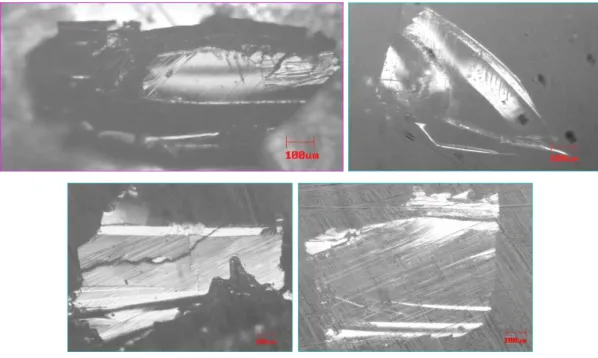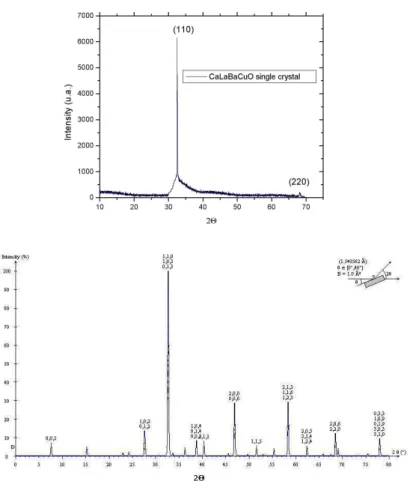Brazilian Journal of Physics, vol. 33, no. 4, December, 2003 733
Structural Properties of CaLaBaCu
3
O
7
−
δ
Single
Crystals Grown by Self-Flux Method
L.T. Corredor
a, D.A. Land´ınez T´ellez
a, Jairo Roa Rojas
a, and J. Albino Aguiar
b(a)Physics of Novel Materials Group, Department of Physics,
National University of Colombia, A.A. 14490, Bogot´a, D.C., Colombia
(b) Laborat´orio de Supercondutividade e Materiais Avanc¸ados, Departamento de F´ısica
Universidade Federal de Pernambuco, 50670-901, Recife, PE, Brasil
Received on 08 September, 2003.
Millimeter-sized single crystals of CaLaBaCu3O7−δwere grown by the conventional self-flux technique. In this report we present a characterization of the structural and morphological properties of our first time grown single crystals. X-Ray diffraction patterns show that the unit cell of the samples corresponds to a tetragonal structure. SEM images evidence excellent morphological properties without presence of twins. EDX measurements show the difficulty of Ca to enter in the structure. The implications of our results are extensively presented and discussed.
1
Introduction
A major problem related to the understanding of the phys-ical mechanisms involved in High Tc superconductivity, is the diversity of properties among different superconductor compounds and essentially, the need of having pure sam-ples, to get information without the influence of the charac-teristic disorder of cuprate oxides. Because of that, growth of single crystals provides the best study tool to access the typical phenomenology of the High Tcsuperconductivity. In the systems RE:123 there is a compound not thoroughly ex-plored, and in contrast with the superconductor Y:123, has a tetragonal structure. It is the CaLaBaCu3O7−δ; [CLBCO] it has been considered to be derived from YBa2Cu3O7−δ [YBCO] by replacement of Y by Ca and randomly, Ba by La.[1, 3] This distribution of Ca and La ions makes the oxy-gen sites O(4) and O(5) in the CuO chains randomly occu-pied, forming in that way, a tetragonal structure indepen-dent of the oxygen content. This compound is a triple per-ovskite structure compound, (a= 3.87 ˚Aand c = 11.71 ˚A, space group P4/mmm) and isostructural with the tetragonal YBa2Cu3O7−δ.[4] In spite of their similarity, contrasting with the YBCO, the boundary between the superconducting and non superconducting phases of CaLaBaCu3O7−δ, is de-fined only by oxygen content, without the complexity of the self-doping effects and the tetragonal- orthorhombic transi-tion of crystalline structure, proper of the YBa2Cu3O7−δ. [5] Since the CaLaBaCu3O7−δ structure remains always tetragonal, independently of the oxygen content, the phase is congruent and the system does not presenttwinsformation. [2] The study of single-crystalline samples of this compound has a great interest, since its properties are unusual
con-trary to the conventional superconducting oxides. Despite its critical temperature being slightly lower, in this system the anisotropy factor is considerably smaller, consequently, the critical transport current density is raised [6], which rep-resents a greater possibility of technological application.
2
Crystal growth
734 L.T. Corredoret al.
of 0.6◦/min. The as-grown crystals have often low and inho-mogeneous oxygen content. Then, they were annealed in O2 atmosphere at 450◦for 7 days. The crystals were placed on a polycristalline CLBCO pellet, inside a quartz tube.
Crys-tals produced in this way had typical dimensions of0.4×0.4
mm2in theabplane, and 0.02 mm along thecdirection. Al-though crystals with larger area were occasionally obtained, their extraction from the flux was very difficult.
Table 1. Stoichiometries and crucibles used
Phase wished Sample Initial stoichiometry Crucible
CaLaBaCu3O7−δ C1 CaLa2Ba2Cu12O7−x ZrO2 C2 CaLa2Ba2Cu10O7−x Al2O3 Ca0.5LaBa1.5Cu3O7−x C3 Ca0.5La1.5Ba3Cu12O7−x Al2O3 C4 Ca0.5La1.5Ba3Cu12O7−x Al2O3 C5 Ca0.5La1.5Ba3Cu12O7−x Platinum
3
Characterization
3.1
Experimental
The morphological properties of the obtained crystals, were initially examined by metallographical microscopy of light reflection and scanning electron microscopy (SEM), obtain-ing the images on Fig. 1. The oxygenated crystals were
examined with energy dispersive X-Ray analysis (EDX) to find out about the correct composition and the presence of second phases. Some were analyzed by X-Ray diffrac-tion technique. The diffracdiffrac-tion patterns were collected by a Shimadzu XRD-6000 diffractometer with Cu Kαradiation
(1.5406 ˚A) at room temperature, and taken from 2Θ=10◦to 70◦. Diffraction data were analyzed by theCarinesoftware for spectrum analysis.
Figure 1. Metallographical and SEM microscopy images: (a) C1-1, single crystal from C1 batch. (b) C2-1. (c) C3-1. (d) C5-1, from up left clockwise.
4
Results and discussion
In the batches C1 and C2 we did not get single crystals with adequate morphological properties, i.e., they presented ir-regular surfaces. Nevertheless, some elongated shaped crys-tals, which we called “needles”, grew together with the
Brazilian Journal of Physics, vol. 33, no. 4, December, 2003 735
twins in the surface of the square shaped crystals (Fig.1d), but posterior characterizations showed their true origin.
With the X-Ray diffraction patterns, intensity and po-sition profiles were fitted to the theoretical pattern of the structural model of the tetragonal form of the Y-123 com-pound, which belongs to space group P4/mmm, i.e. replac-ing Yttrium by Calcium and one Lanthanum in one Barium site. This pattern belongs to the polycristalline compound, since there are not reports about CLBCO single crystals. We compared the positions and intensities of both patterns, only for the peaks involved in the single crystal one. These are shown in Fig. 3. This figure shows two main peaks in the experimental pattern: (110) and (220), which evidence the
oriented growth of the sample. It becomes evident, from this figure, that the coincidence is total with the analogue peaks in the polycristalline pattern, both in position and intensity relation, besides of coinciding with other reports about the polycristalline compound.[9, 11, 12] It appears to be quite interesting that the single crystal grew in a different orienta-tion of the expected one, i.e., with thecaxis perpendicular to the crystal’s surface, like YBCO single crystals.[13, 14] This is the explanation for the lines on the single crystal’s surface, corresponding to oriented planes, not to twins. By means of pattern fitting, we obtained the cell parametercas c = 11.71(4) ˚A, with a = b = 3.87(7) ˚A; these results agree with previous reports.[15]
Figure 2. (a) Alumina crucible with needle-shaped single crystals no extracted (b) needle extracted from batch C4.
736 L.T. Corredoret al.
Figure 4. EDX analysis for C4-1 CaLaBaCuO single crystal.
The EDX analysis (Fig. 4) shows the proper peaks and gives an indication of the pure-phase character of the sam-ple. This analysis revealed that in all the batches there were second phases present, like CuO, corresponding to the nee-dles discussed above. LaBaCuO crystals were often ob-tained too; all the batches revealed a possible difficulty in the entrance of calcium into the structure. On this regard, there are reports from Y:123 doped with calcium, in which the calcium enters into the phase-pure structure only up to 15%.[16] After this limit, other phases begin to appear. In brief, although it is found that the calcium introduction im-proves the carrier density, and therefore the superconduc-tor properties, the calcium’s entry is not always reached .[17]This is due to the reduced ionic radio of calcium (2.23
˚
A), that although is similar to the yttrium’s (2.27 ˚A), is re-duced compared with the lanthanum’s (2,.74 ˚A) and bar-ium’s (2.78 ˚A); these occupy randomly the same sites as cal-cium. Consequently, the solid solubility is limited. Never-theless, it is noticeable the absence of Al and Au in samples from C2, C3 and C4. In the case of C5, we obtained samples with the adequate properties, besides of no contamination, except for the crystals removed from the walls. Further in-vestigation of these crystals are under way, aimed to verify their superconductor character.
Acknowledgements
This work was partially supported by the DIB (Ba-sic Investigations Department from National University of Colombia) projects code 803640 and 803760 and the Brazil-ian agencies CNPq, and FACEPE.
References
[1] Y. Yokura, J.B. Torrance, T.C. Huang, and A.I. Nazzal, Phys. Rev. B38, 7156 (1988).
[2] D.M. de Leeuw. C.A.H.A. Mutsaers, H.A.M. van Hal, H.
Ver-wij, A.H. Carim, and H.C.A. Smoorenburg, Physica C156, 126 (1988).
[3] T. Bjornholm, I.K. Schuller, E.A. Early, M.B. Maple, B. Wuyts, J. Vanacken, and Y. Bruynseraede, Phys. Rev. B.41, 11154 (1990).
[4] R.A. Gunasekaran, J.V. Yakhmi, and R.M. Iyer, Physica C
208, 143 (1993).
[5] K. Yamaya, T. Yagi, and Y. Okajima, Solid State Comm.87, 1113 (1993).
[6] J.L. Peng, P. Klavins, R.N. Shelton, and H.B. Radousky et al., Phys. Rev. B.39, 9074 (1989).
[7] L.F. Schneemeyer, J.V. Waszcak, and T. Siegrist et al., Na-ture328, 601 (1987).
[8] E.F. Righi, S.A. Grigera, G. Nieva, and F. De la Cruz, Super-conductivity Review2, 205 (1998).
[9] J.M.S. Skakle and A.R. West, Physica C220, 187 (1994).
[10] T. Mertelj, P. Stastny, F.C. Matacotta, P. Ganguly, and C.U. Segre, Physica C183, 11 (1990).
[11] V.P.S Awana and A.V. Narlikar, Mod. Phys. Lett B15, 415 (2001) 415.
[12] Y. Sato., M. Valkeap¨a¨a, V. Petrykin, M. Osada, H. Rundl¨of, S. Eriksson, and M. Kakihana, NFK Experimental Report No.549 (2002).
[13] S.N. Barilo, A.P. Ges, S.A. Guretskii, D.I. Zhigunov, A.V. Zubets, A.A. Ignatenko,A.N. Igumenster, I.D. Lomako, A.M. Luginets, V.N. Yakimovich, and L.A. Kurochkin, J. Crystal Growth119, 403 (1992).
[14] J.P. Rice and D.M. Ginsberg, J. Crystal Growth109, 432 (1991).
[15] J.M.S. Skakle and A.R. West, Physica C241, 191 (1995).
[16] V.P.S. Awana, A. Tulapurkar, S.K. Malik, and A.V. Narlikar, Phys. Rev. B 50, 549 (1994).
[17] S.K. Malik, W.B. Yelon, and V.P.S. Awana Mod. Phys. Lett.


